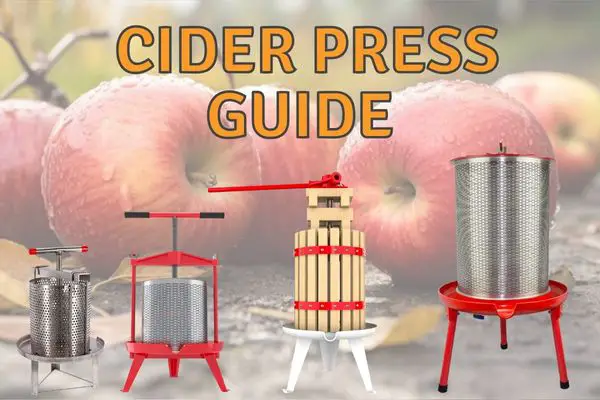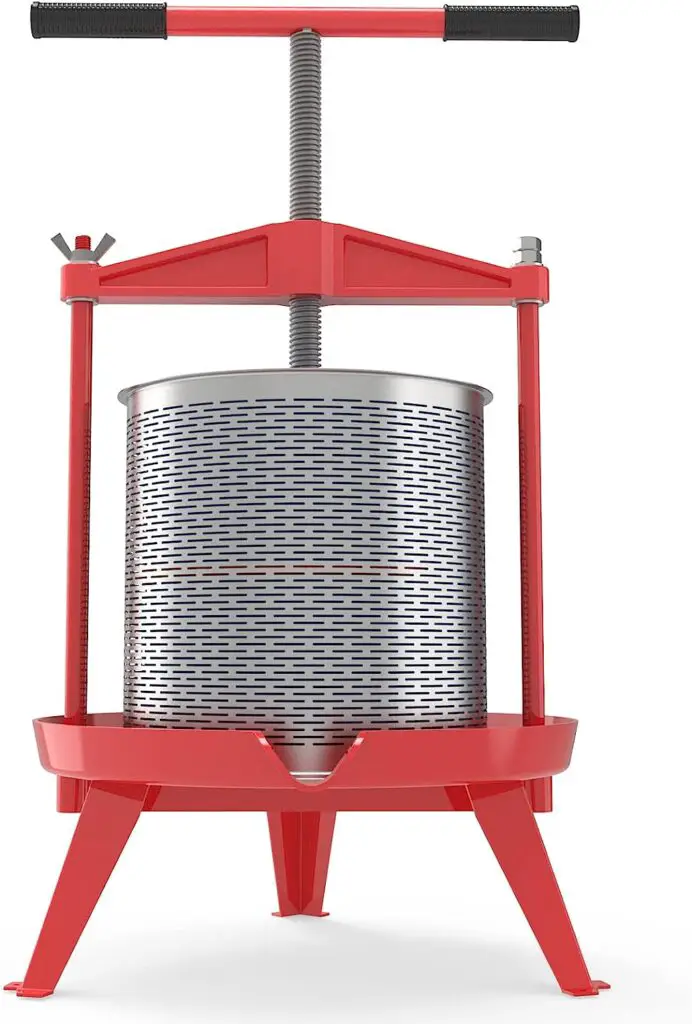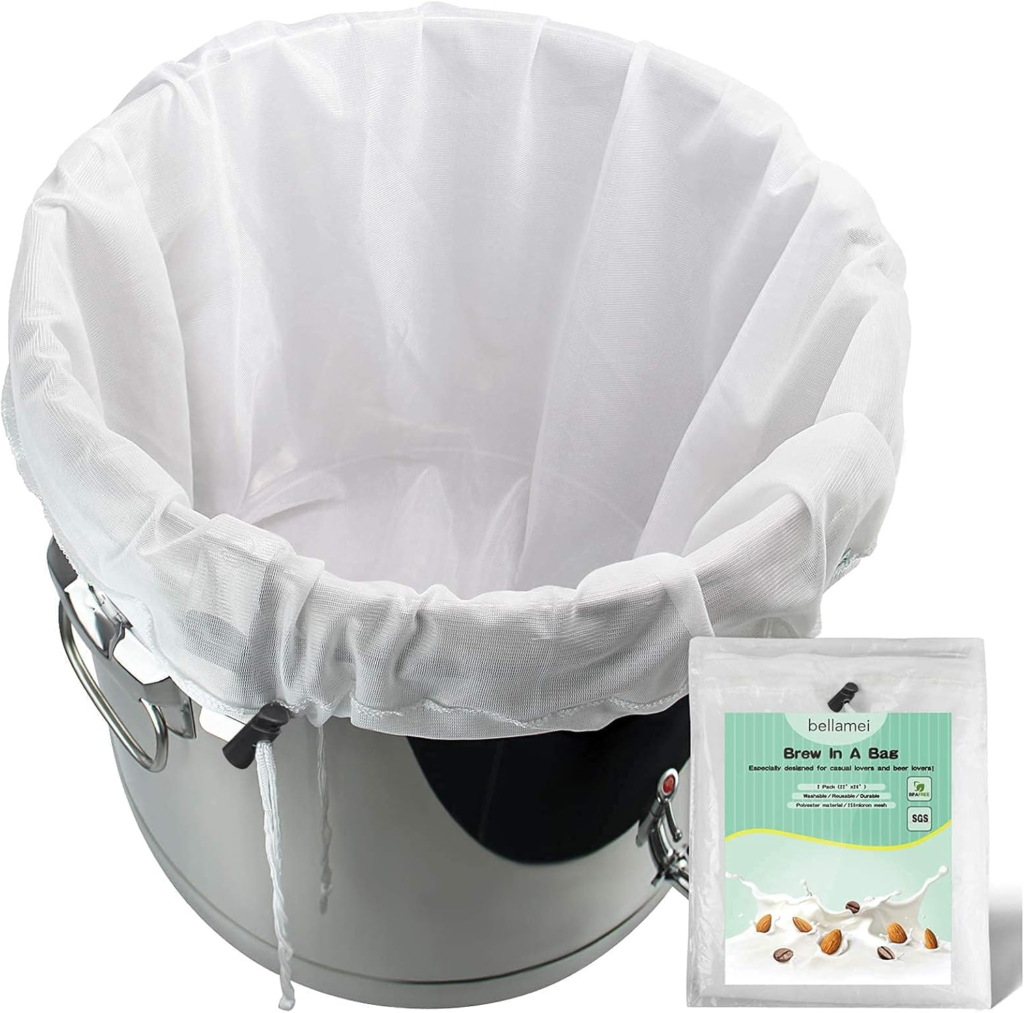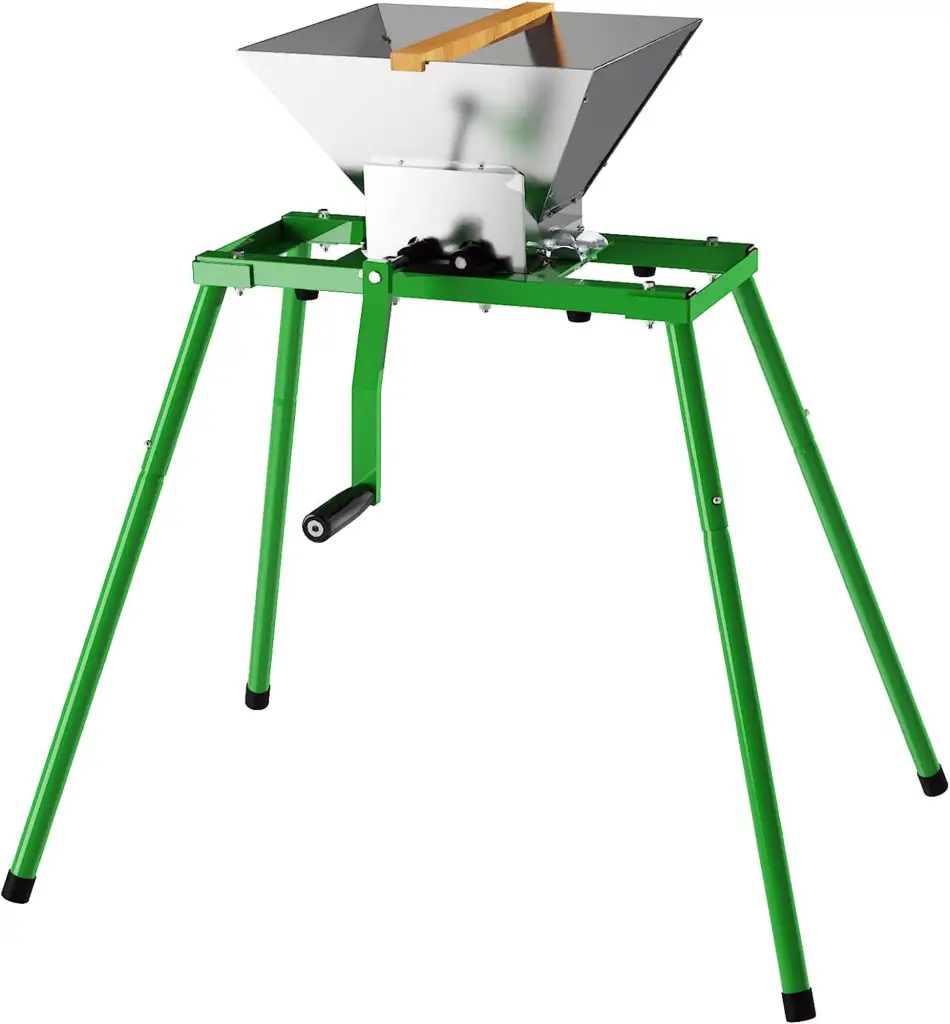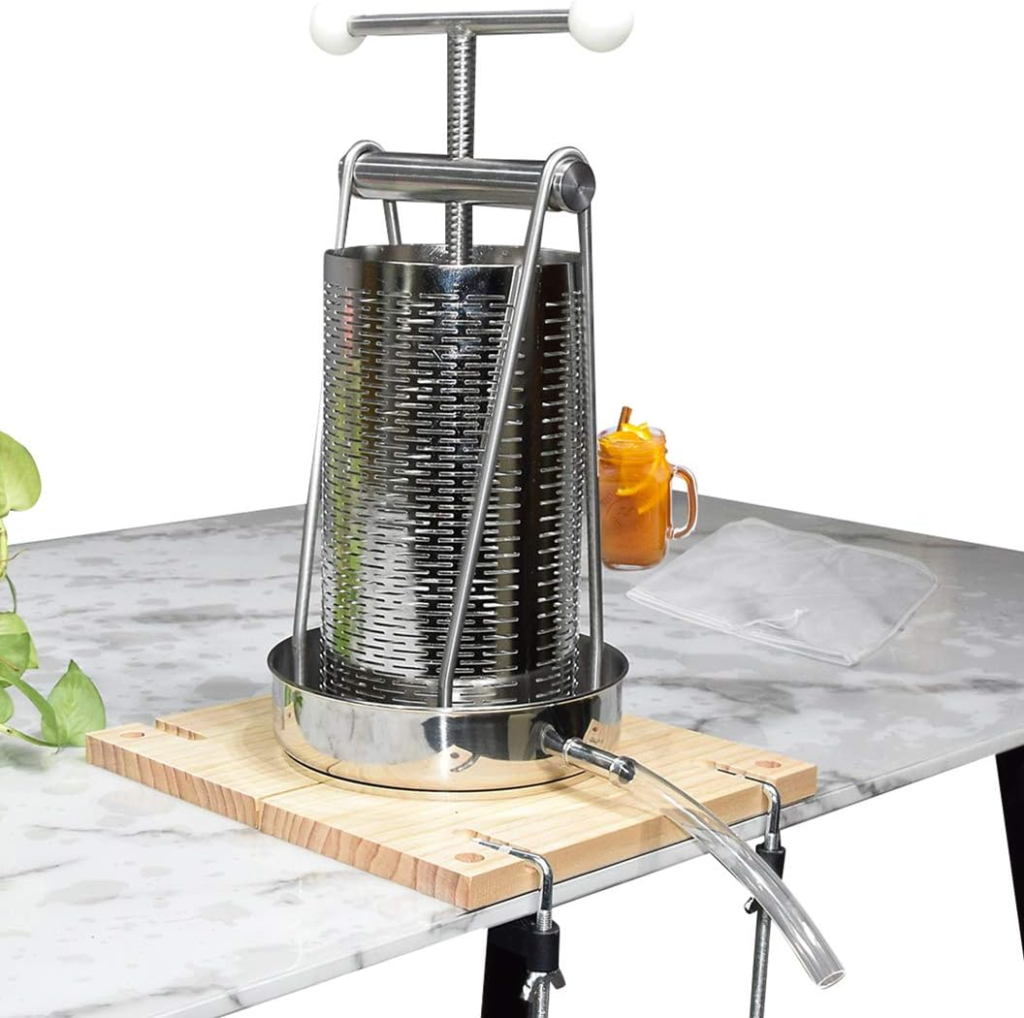Whether you’re interested in learning about traditional manual presses or state-of-the-art electric models, this guide has got you covered.
We’ll explore some of the features of different types of presses and discuss what makes them suitable for certain uses.

So read on to learn more about how to make sure you find the perfect apple press for your next batch of homemade cider!
Why press your own cider?
The process of pressing your own cider allows for you to get the most out of your apples.
Pressed cider has more intense and fresh flavor than store bought cider because of the less damaging (cold) process of extracting juice from the apples. It’s also better for the environment I guess.
You can also decide exactly what apples to use and you can use your own apples and even mix in other fruits to make a more interesting juice.
When using the juice for brewing, home pressing also allows you to control which microbes are carried over when fermenting the juice into hard cider later on, and whether you want to filter the cider or add pectic enzyme or not!
Additionally, pressing your own cider can be a fun, family-friendly activity that allows you to make something delicious together.
No matter the pressing method, you will (roughly) follow the steps outlined below:
- Gather the necessary supplies: a grinder, a press, a large bucket, a large strainer, cheesecloth, and your fresh apples.
- Wash the apples and (depending on the method) cut them into smaller pieces.
- Use a grinder (either manual or electric) to crush the apples into pulp.
- Press the apples: Place the apples in the press and press to extract the juice.
- Strain the juice: Pour the juice into the bucket through the strainer.
- Optional: Line the strainer with cheesecloth and strain the juice again.
- Discard the pulp and pour the juice into a clean (fermentation) container.
- Store the juice in the refrigerator until ready to drink or directly ferment into hard cider.
As such, the process of pressing juice of apples for use as fermentation substrate for hard cider is simple.
So let’s get into how to choose the optimal press for your needs!
Best Apple Cider Presses for Beginners
When deciding on an apple press to buy, you need to consider the mechanism, capacity, material and price of the press so that it will fit your needs.
The most common type of apple press is the traditional hand-crank press.
Heavy-duty Hand Press
The Best Option for Beginners
I recommend this metal version over the wooden one as it is way easier to clean and much easier to operate.
- 14L (3.7 Gallon) capacity
- Stainless steel lasts forever
- Much easier to clean compared to wooden ones
- Cross-beam for extra force
- Comes in a bundle with grinder etc.
This type of press requires some physical effort to operate and can be used for both small batches of cider as well as larger batches. It is also relatively inexpensive compared to other types of presses.
Increasingly popular among amatour brewers are hydraulic presses, which use pressure from oil or water to extract juice from apples with minimal effort required by the user.
These machines tend to be more expensive but reliable and efficient, which is why they are usually also used in commercial settings such as breweries or wineries where they need to produce large amounts of juice quickly and efficiently without sacrificing quality control standards.
Wooden Hand Press
Best Budget Option
I recommend this wooden press if you are still a bit unsure about the hobby and want a quick start without breaking the bank.
- Numerous capacity options (1.6 – 8 gal)
- Cheap and lightweight.
- Easy to use
- Multiple bundle (with a crusher) options.
No matter what kind of cider press you choose, it is important to keep it clean and properly maintained so that your ciders come out tasting great every time.
The ability to clean a cider press (you will discover!) is also a crucial feature, and here the material is very important (read my story later on mold growth in my first cider press…!).
Therefore I recommend pairing the wooden press with a mesh filter bag to avoid squeeze-out of the apple mash.
Presses come in a variety of materials, such as oak, aluminium, cast iron and stainless steel. Oak apple presses are the most traditional option for cider making and produce high-quality ciders with rich flavors, but are less efficient and are hard to clean properly.
Finally, stainless steel apple presses can be very efficient at extracting juice from apples due to their strong construction.
Hydraulic presses are made from stainless steel, which makes them sturdy and offer greater control over the pressing process.
Hydraulic Fruit Press
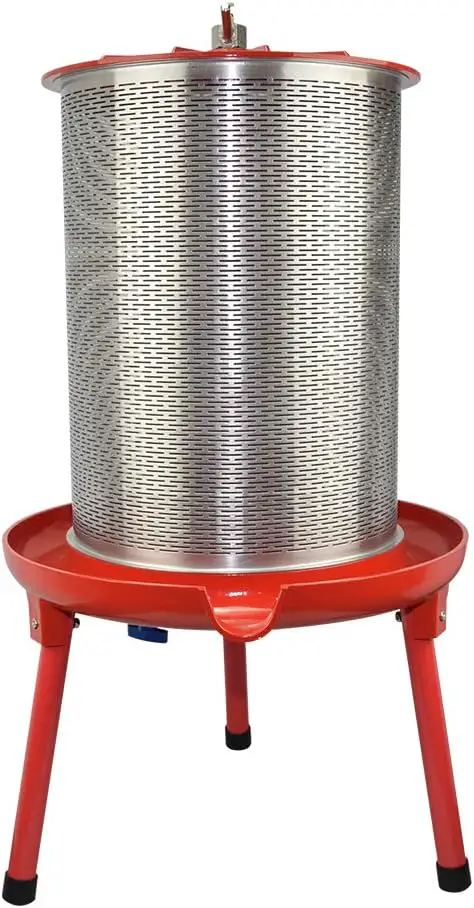
The Most Efficient Option
This press is the best value for money in my opinion. It runs off of the pressure of a garden hose instead of manual labour or electricity!
- From 4 to 24 gallon capacity
- Super easy and fast operation (30min)
- Great yield (low juice waste)
- Runs on water pressure (garden hose)
- Easy to clean and maintain
Aluminium apple presses are lightweight and affordable, but don’t provide quite as effective results as other models, bend more easily and might dissolve trace amounts of metal into your (acidic) juice!
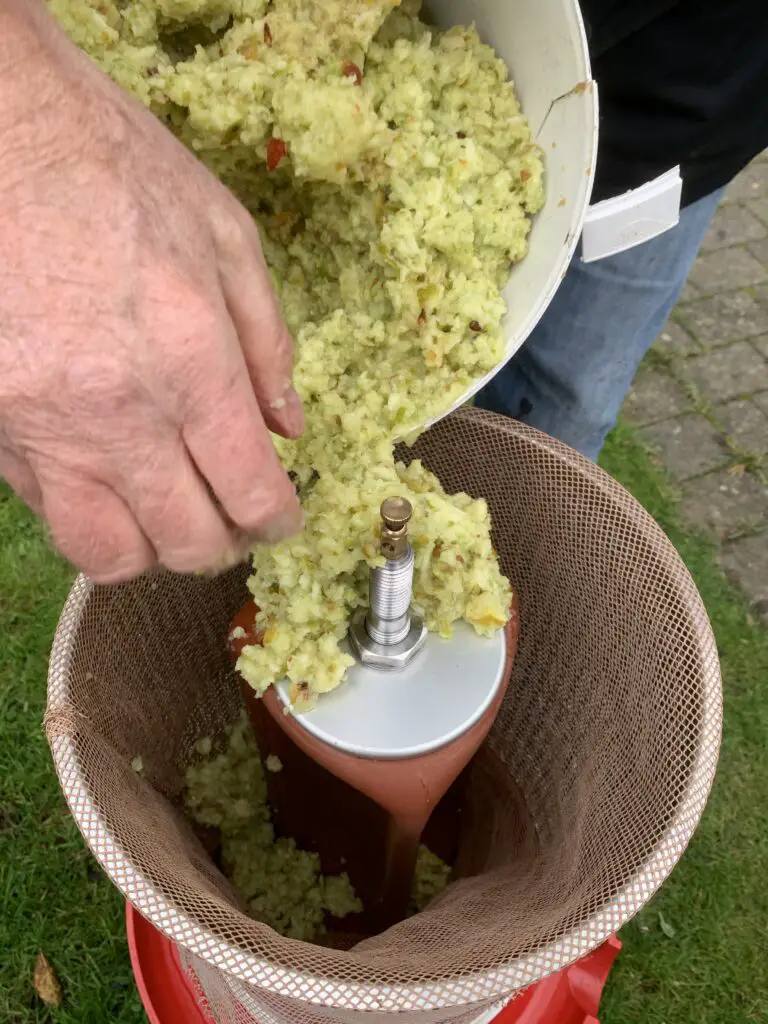
Cast iron apple presses offer great durability and strength while providing an even press that produces consistent quality, but is also susceptible to rust. And they are heavy!
Remember the grinder!
All of the presses listed here work much better if paired with a quality apple grinder. Even the best apple press is only as good as its grinder and they do not have to be expensive.
Manual Apple Crusher
I recommend the one above for most hobby purposes as the next step would be a large scale electric grinder.
For hobby purposes I use the one above with an electric drill attached instead of the handle, which makes it much easier to operate…
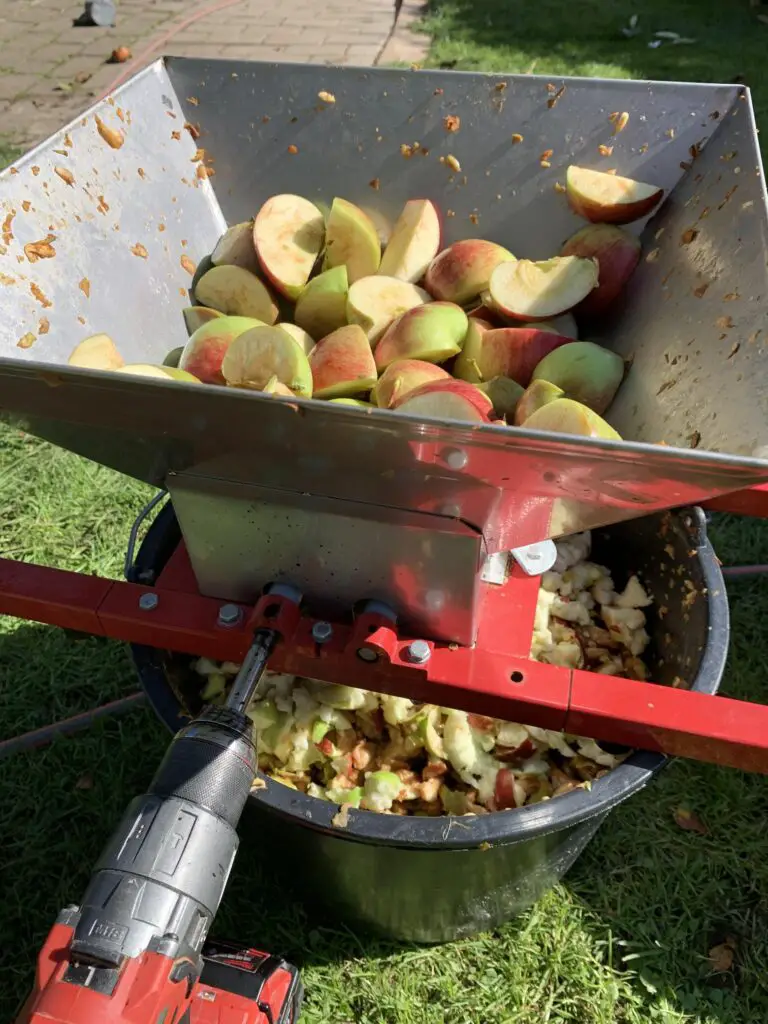
I’ve also tried a few larger electric grinders and the best option, which comes at the fraction of the price of a “real” electric fruit grinder, is a wood chipper – yes it works really well with apples!
I would recommend that one if you plant to grind more than 200 pounds of apples at a time.
Cider Press For Small Spaces
Try a smaller tabletop version. My uncle, who lives in an apartment but has access to apples in his courtyard, use the small table top press shown below to make a few gallons of hard cider each fall!
Steel Table Top Press
All types of apple presses have advantages and disadvantages depending on your budget and needs when it comes to cider making.
Alternatively, you might consider a kitchen grade juicer instead, which is smaller and faster – and most importantly – abolishes the need for a separate grinder. But the throughput is also lower, and the machine will wear down faster in my experience…
So it’s important to consider all options carefully before deciding which one is right for you.
Types of Apple Presses and How They Work
Now, let’s take a look at how the different cider presses work.
Manual Pressing
When it comes to pressing juice for cider, one of the most common methods is manual pressing. This involves using a press that has two plates with ridges on them and a handle that can be turned to apply pressure.
The apples are placed between the two plates and then the handle is turned in order to squeeze out as much juice as possible.
The pressure squeezes the juice out the sides of the press. Sometimes you have to add blocks of wood to support the pressure block as the volume of crushed apples compress (which is annoying).
That is why I usually recommend a press with a support beam instead.

I made the mistake of initially buying a wooden version of the hand press as my first cider press. It worked fine for smaller batches, but it is much harder to clean than the stainless steel version and we had massive mold growth on (and inside!) the wooden beams, which ended up contaminating multiple cider batches…

This method works best when you have small batches of apples, or if you want to get more control over how much juice is extracted from each apple.
Hydraulic Pressing
Hydraulic pressing is another popular option for extracting juice from apples for cider-making. This method uses a hydraulic cylinder/balloon, which applies pressure directly onto the apples, squeezing out all of their juices quickly and efficiently.

A hydraulic press is assumed to be 20-30% more efficient than a hand operated press as the pressure is distributed more evenly across the pulp and can be much higher than most hand presses (although the stainless steel cross-bar hand presses come close!).
It’s great for larger batches since it can process many pounds of fruit at once without having to manually turn a handle like with manual presses.
However, this type of press requires more setup time than manual presses do so it may not be ideal if you’re pressed for time or working with smaller batches of fruit.
Electric cider presses
The case of electric presses is a bit more complicated as they are either small juicers for super low throughput kitchen use or larger commercial ones.
Electric cider presses are machines that use electricity to press apples and extract their juice for cider making. There are several types of electric cider juicers available in the market, ranging from small home models to larger commercial ones:
- Home models: These are smaller electric cider presses designed for home use. They are typically more affordable and take up less space than commercial models.
- Commercial models: These are larger electric cider presses designed for commercial use. They are generally more expensive but can process larger volumes of apples.
Pros:
- No grinder needed!
- Efficiency: Electric cider presses can process large amounts of apples quickly and efficiently, allowing you to make a lot of cider in a short amount of time.
- Consistency: Electric cider presses can provide a consistent amount of pressure, which can result in a more consistent yield of juice and better quality cider.
- Ease of use: Electric cider presses are generally easier to operate than manual presses, as they require less physical effort and can be operated with the touch of a button.
Cons:
- Cost: Electric cider presses can be expensive, especially the larger commercial models. This may not be a viable option for small-scale cider makers.
- Maintenance: Electric cider presses require regular maintenance to keep them in good working order. This can include cleaning, lubricating, and replacing parts as needed.
- Size: Electric cider presses can take up a lot of space, especially the larger commercial models. This may not be ideal for home cider makers with limited space.
I generally would not recommend these except you are doing very small experimental batches.
Traditional Ram Presses
Using a traditional cider ram press for apple cider making has both advantages and disadvantages.
One of the main advantages is that it is a traditional and authentic way of making cider. This can add to the appeal of the final product for those who are interested in preserving or recreating historical practices.
The traditional press also allows for more control over the process, as the operator can adjust the pressure exerted on the apples to achieve the desired juice yield and quality.

However, traditional cider ram presses can also have some drawbacks. One major disadvantage is that they require a lot of physical effort to operate.
The operator needs to manually turn a large screw or handle to press the apples, which can be tiring and time-consuming. Additionally, traditional presses can be bulky and difficult to move, which may be a consideration for those with limited space.
There are different types of traditional cider ram presses available, which vary in their design and capacity.
Some presses are made entirely from wood, while others have metal components. The capacity of the press also varies, with some being suitable for small batches of cider and others capable of handling larger quantities.
In terms of who traditional cider ram presses are for, they are generally suitable for individuals or small-scale cider makers who are interested in using traditional methods. They may also appeal to those who are interested in DIY projects, as they can be built from scratch using plans available online or in books.
It is worth noting that traditional cider ram presses can be hard to come by, as they are not widely produced commercially. Those interested in using one may need to build it themselves or seek out second-hand options. However, for those who are passionate about cider making and interested in preserving traditional techniques, a traditional cider ram press can be a valuable tool.
Steam Juicing
I don’t own a steam juicer myself as it is mostly an industrial thing, but I thought it was worth mentioning.
Steam juicing is another way to extract juice from apples for making cider. Instead of applying direct pressure onto the fruit itself, steam heat is used to break down cell walls within the apple flesh and release its juices into an awaiting container below it during processing time frame.
This method works well when dealing with large amounts of fruit since there’s no need to manually turn handles or set up hydraulic cylinders beforehand; however, some argue that this method doesn’t yield as flavorful results compared other methods due its reliance on heat rather than mechanical force alone.
Other Things to Consider
When buying a new cider press, there are some things you want to consider before choosing the best option for you. These relate to the capacity, maintenance requirements and efficiency of the press and how much money you are willing to spend.
Capacity Requirements
When choosing a fruit press for cider making, it’s important to consider capacity requirements. If the press is too small, you won’t be able to produce enough cider in one go. On the other hand, if it’s too large, you may end up wasting resources and money.

A cylinder press is usually best for larger batches of cider. It consists of two cylinders — an outer sleeve and an inner plunger — which are used to compress apples into juice.
This type of press can handle between 12-24 kgs of apples at once, depending on its size. That makes it ideal for producing multiple gallons of cider in a single session.
If you’re only making smaller batches, however, then a traditional fruit press might work better for your needs. This kind of press features a basket or hopper where you place the cut apples before pressing them through the perforated plate underneath.
The amount of juice produced will depend on how much pressure is applied – but typically they’ll process around 4 kgs per hour with ease.
In short, when selecting an apple press for cider making it’s essential to assess your specific capacity requirements first so that you make sure you get the right equipment for job.
Cost Considerations
When it comes to cost, there are several factors that need to be considered. First and foremost, the budget for purchasing an apple press should include both the price of the machine itself as well as any additional items needed such as filters or grinder blades. It’s important to factor in these costs when deciding on a particular model.
Another key consideration is how frequently you intend to use your apple press. If you only plan to make cider occasionally then opting for a cheaper model may be more suitable, whereas if you will be making larger batches of cider regularly then investing in a higher quality hydraulic press machine could save money in the long run due to increased efficiency and durability.
The size of your batch can also have an impact on costs; smaller presses tend to require less apples per pressing cycle than larger models so this should be taken into account too.
Additionally, some machines come with accessories such as fruit crushers which may add extra expense but also increase convenience and speed up production time significantly.
Ultimately, choosing the right apple press requires careful research and thought about what best fits your needs both financially and functionally.
Before making a purchase, it’s wise to read reviews from other users and compare prices between different suppliers – this way you can ensure you get value for money without compromising on quality or performance.
Accessories For Apple Presses
Now that the cost of an apple press has been taken into account, it’s time to look at what other features and accessories come with a press.
After all, there is more than meets the eye when selecting an appropriate device for cider making. Here are some items to consider:
- A pair of wooden blocks or railings – These will help stabilize your grinder while you’re pressing apples.
- Mesh bags – Use these bags to place your chunks of fruit in before inserting them into the press. They’ll keep the pieces from getting stuck together and ensure maximum juice extraction.
- Collection bucket – Look for one with a spigot on the bottom so you can easily drain out your freshly-pressed cider without having to lift and pour heavy containers.
- Flywheel or longer leaver – These parts help make turning easier during the pressing process. It allows smooth acceleration as well as deceleration, creating even pressure throughout the cycle.
All of these accessories should be considered when looking for an apple press since they can play a big role in how successful cider making is.

Don’t forget about any additional parts that may need replacing over time too; such as belts, blades, or bearings – depending on which type of press you purchase!
Taking this all into consideration should give aspiring cider makers peace of mind knowing their apple presses are up to par for quality production and results every season!
Proper Care And Storage Of The Apple Press
One of the most important aspects of making cider is properly caring for and storing your apple press. Just like any other kitchen tool, regular maintenance will keep it running smoothly and producing delicious ciders.

Take my story as an example; we bought a high-quality wood press but didn’t take proper care of it. After just one season our press was in need of repairs and full of mold growth that could’ve been avoided with some simple preventative measures.
To start off, you’ll want to make sure you clean your wooden apple press very well with antiseptics like bleach or hydrogen peroxide.
Allowing fruit residue to build up on the parts of the press can lead to rusting and corrosion over time, reducing its lifespan significantly. This step is especially important after pressing softer fruits such as strawberries which tend to leave more sticky residue behind than firmer apples do.
When not in use, store your apple press indoors away from extreme temperatures or humidity levels. If stored outside, even covered by a tarp, the sun’s rays may damage the metal components while moisture can cause mold and mildew growth on wooden presses.
Additionally, if you plan on buying a used apple press from someone else check for signs of wear before purchasing so that you know what kind of condition it’s in when bringing it home.
Finally, make sure to inspect all the parts regularly for any signs of wear or tear since replacing them quickly can save you money down the line.
You should also oil moving parts every few months using food grade oils such as coconut oil or mineral oil to ensure they don’t seize up due to lack of lubrication. Doing this little bit of maintenance each year will extend your equipment’s life expectancy immensely!
Frequently Asked Questions About Cider Pressing
So now that you know about cider presses, you might want to know a bit more about the apples to choose and the process itself.
What Kind Of Apples Should I Use With My Apple Press?
When making cider with an apple press, the type of apples you use is just as important as the quality of press itself. Depending on your desired taste and consistency, some types of apples may be better than others for your particular project.
If you want to use your cider for fermentation into alcoholic hard cider, I have written a whole article about the best apple varieties to use for this purpose.
For a light and refreshing drinking cider, tart green or yellow apples can provide just the right balance between sweetness and acidity. Granny Smiths, Golden Delicious, and Jonathan Apples are all excellent choices here.
However, these do not provide much taste after fermenting all the sugars away!
For those looking to make something more full-bodied and complex, go for redder varieties such as Rome Beauty or Ida Red. A mix of these two kinds will create a unique blend that has both sweetness and depth.
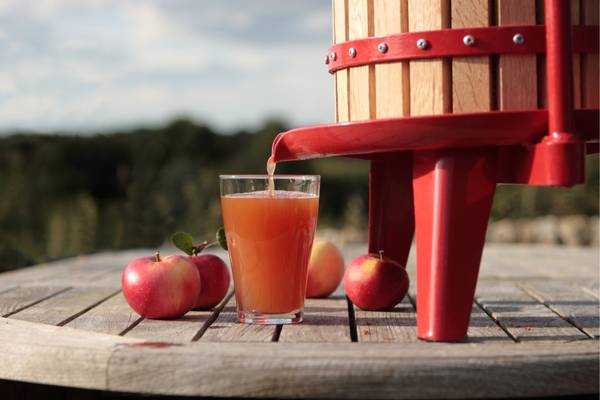
If you want a richer flavor, consider adding some heirloom varieties into the mix too – Winesap or Northern Spy are both excellent options for this purpose. You could also try adding in fruit like pears or cranberries if you’re feeling adventurous! This way you’ll get even more complexity out of your finished product.
No matter what kind of apples you choose, it’s important to ensure they’re fresh and ripe before pressing them.
Riper fruits will have higher sugar content which translates into increased alcohol levels in your cider – so don’t skimp on quality when selecting your produce!
With the right combination of ingredients and technique, you’ll soon be enjoying delicious homemade cider made from freshly pressed fruits.
How Long Will It Take To Make Cider With An Apple Press?
Time is of the essence when it comes to making cider with an apple press. As the old adage goes, “time and tide wait for no man”, so having a good understanding of how long your process will take can be essential for success.
The time taken to make cider with an apple press depends on several variables such as the type of apples you use, the number of apples being pressed at any one time and even the quality of the press itself.
For example, if you choose to use ripe apples or overripe apples they may require less pressure during pressing than firmer, under-ripe fruit would need. Additionally, if you have a manual press then it’s likely that your pressing speed will be slower than if you had opted for an automated machine which could handle larger batches in shorter periods of time.
Once the juice has been extracted from the fruit there are further steps involved in turning it into delicious hard cider. Generally speaking this involves allowing fermentation to occur naturally or by adding yeast cultures before transferring it into bottles or barrels where carbonation can happen.
This fermentation process usually takes between 4 weeks and 6 months depending on things like temperature and specific gravity levels but again these factors vary based on personal preference and desired taste profile.
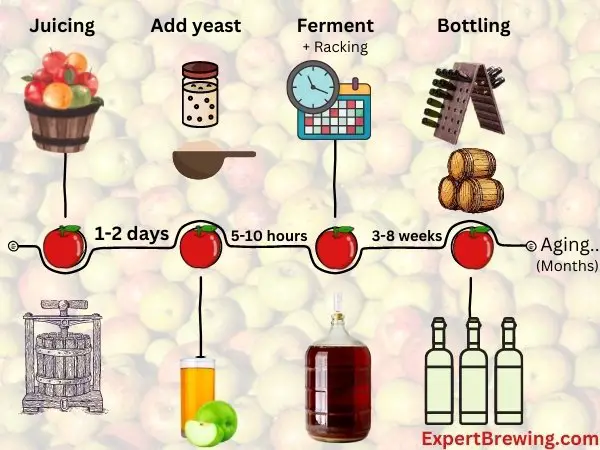
Overall, although creating tasty homemade cider requires patience, knowledge and some trial and error, it certainly doesn’t have to take forever!
With careful planning, attention to detail and access to high-quality equipment such as an appropriate apple press, there’s no reason why you shouldn’t be able to enjoy great tasting cider within a few short weeks – cheers!
Does The Apple Press Need To Be Assembled?
When choosing an apple press for cider making, one of the considerations is whether or not it needs to be assembled. This can make a difference in how much time and effort you’ll need to put into your project before you have a working device.
Assembling an apple press requires following instructions carefully and taking your time. It also helps if you’re familiar with tools like screwdrivers and wrenches; this way, you can get the job done more easily. On the other hand, some presses come pre-assembled, meaning all that’s required is unpacking them and starting up the process of pressing apples for cider.
In either case, it’s important to consider factors like quality materials used in construction as well as customer reviews from previous buyers who’ve had experience using similar devices. Doing so allows you to determine which type of apple press would work best for your specific needs when making cider at home.
It’s also worth noting that some presses are designed specifically for commercial use while others are intended strictly for personal use. Therefore, researching different types available on the market will help ensure that you purchase one that meets both your budget and expectations for producing delicious cider.
Are There Any Safety Precautions To Consider When Using An Apple Press?
When using an apple press, it is important to consider safety precautions. Operating the machine can be dangerous if proper measures are not taken. It is essential to read over the user manual and familiarize yourself with its components before use. Additionally, ensure that you are wearing protective clothing such as gloves and a face mask to protect against any splinters or debris produced by the machine.
It’s also wise to take great care when lifting and moving the machine due to its significant weight. To reduce risk of injury, use a dolly or lift assist device; this will make it easier to maneuver around tight spaces or up stairs. Furthermore, always place the appliance on even ground away from other machinery or equipment in order to prevent tipping or falling down unexpectedly.
In addition, inspect all parts prior to operation for signs of damage or wear-and-tear which could lead to malfunctioning during use. Keep small objects clear from where you’re pressing apples so they don’t get caught in between gears or blades – this can cause serious harm if not detected quickly enough!
Lastly, never attempt repairs unless qualified personnel have been consulted first; otherwise there may be risks of further damaging the product and creating hazardous conditions for those nearby.
To sum up: being mindful of these safety tips when operating your apple press will help keep both you and others safe while producing fresh cider at home!
Are There Any Health Benefits To Drinking Cider Made With An Apple Press?
The health benefits of drinking cider made with an apple press are plentiful, and they range from boosting immunity to protecting against certain diseases. While many people associate the consumption of alcohol with negative side effects, there has been a recent surge in research on how some alcoholic beverages, such as cider created using an apple press, can be beneficial for one’s health.
For starters, moderate intake of fermented cider may help support healthy gut bacteria due to its probiotic properties – this could even benefit those who suffer from digestive issues or food intolerances. The presence of antioxidants found in apples is also thought to provide anti-inflammatory benefits throughout the body. Additionally, studies suggest that consuming antioxidant-rich drinks like cider can reduce the risk of developing chronic illnesses such as heart disease or cancer.
Whilst it’s important to remember that excessive drinking isn’t good for your health and should always be done responsibly, choosing to enjoy a glass of freshly pressed cider every now and then could actually offer you some unexpected rewards. The natural sugars present in apples have also been claimed to act as a stimulant while providing energy; perfect if you’re looking for an afternoon pick-me-up!
Fermenting apples through a traditional apple press offers numerous advantages over store-bought ciders; not only does it retain more nutrients but it tastes better too! So why not try making your own? With so many potential benefits associated with moderate consumption, homemade cider might just become your new favourite drink!
Conclusion
When choosing an apple press for cider brewing, there are a few factors to consider:
- Capacity: The size of the press should be chosen based on the amount of apples you plan to juice. If you have a large orchard and plan to make a lot of cider, you’ll want a press with a larger capacity. If you’re just juicing a few trees, a smaller press will suffice.
- Material: Presses can be made from wood, metal, or plastic. Wooden presses are traditional and offer a classic look, but they can be more difficult to clean and maintain. Metal presses are more durable and easier to clean, but they can be more expensive. Plastic presses are the most affordable and easy to clean, but they may not last as long as metal or wooden presses.
- Type: There are two main types of apple presses: hydraulic and screw. Hydraulic presses use water pressure to squeeze the juice out of the apples, while screw presses use a rotating screw to apply pressure. Hydraulic presses are typically more expensive but are faster and easier to use. Screw presses are slower but can be more precise and efficient.
- Price: The price of an apple press can vary greatly depending on the type, capacity, and material. Consider your budget and how often you plan to use the press before making a decision.
- Reviews: Finally, it’s a good idea to read reviews from other cider makers to get a sense of the pros and cons of different presses. Look for reviews that mention ease of use, durability, and juice yield.
By considering these factors, you should be able to choose the perfect apple press for your cider brewing needs.

